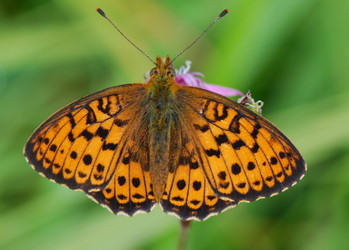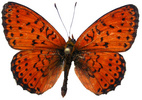Brenthis
Thomas Simonsen, Niklas Wahlberg, and Andrew V. Z. Brower


This tree diagram shows the relationships between several groups of organisms.
The root of the current tree connects the organisms featured in this tree to their containing group and the rest of the Tree of Life. The basal branching point in the tree represents the ancestor of the other groups in the tree. This ancestor diversified over time into several descendent subgroups, which are represented as internal nodes and terminal taxa to the right.

You can click on the root to travel down the Tree of Life all the way to the root of all Life, and you can click on the names of descendent subgroups to travel up the Tree of Life all the way to individual species.
For more information on ToL tree formatting, please see Interpreting the Tree or Classification. To learn more about phylogenetic trees, please visit our Phylogenetic Biology pages.
close boxIntroduction
There are currently four species recognized in the genus Brenthis. These small to medium sized fritillaries are distributed throughout the Palaearctic (Tollman & Lewington 1999, Tuzov 2003). All Brenthis species lack silver spots on the undersides of the wings. Contrary to most Argynnini, Brenthis larvae do not feed on violets, but instead on members of the rose-family and on legumes (Tuzov 2003).
Characteristics
Putative autapomorphies for Brenthis include (Simonsen 2006):
- Uncus trifid
- Ampulla of the male valve long and dorso-ventrally flattened with dorsal microtrichia
- Fenestrula on the male tegumen arrowhead shaped
- Female abdominal venter 8 with a latero-anterior rectangular process
Putative synapomorphies for B. hecate, B. mofidii (Simonsen 2006):
- Male latero-ventral tergal sclerite broad, triangular and pointed downward
- Female anterior apophysis membranous, but with a sclerotized tip
- Dorso-posterior corner of female S7 bent sharply inwards
The sister group relationship between B. ino and B. daphne is supported by molecular and combined charactersets only and no morphological synapomorphies have yet been identified.
Discussion of Phylogenetic Relationships
All four species of Brenthis, have been sampled for morphology based phylogenetic studies (Simonsen 2006). The study by Simonsen et al. (2006) did not sample B. mofidii, but recent molecular data (N. Wahlberg, unpublished) corroborate the position of B. mofidii as the sister species to B. hecate. The monophyly of the genus appears to be stable and well-supported by both molecular and morphological data.
References
Simonsen, T. J. 2006. Fritillary phylogeny, classification and larval hostplants: reconstructed mainly on the basis of male and female genitalic morphology (Lepidoptera: Nymphalidae: Argynnini). Biological Journal of the Linnean Society 89: 627-673.
Simonsen, T. J., N. Wahlberg, A. V. Z. Brower, and R. de Jong. 2006. Morphology, molecules and Fritillaries: approaching a stable phylogeny for Argynnini (Lepidoptera: Nymphalidae). Insect Systematics & Evolution 37: 405-418.
Tollman, T. & Lewington, R. 1999. Butterflies of Britain and Europe. Collins Field Guide. Harper Collins Publishers.
Tuzov, V. K. 2003. Guide to the butterflies of the Palaearctic Region. Nymphalidae part I. Tribe Argynnini: Argynnis, Issoria, Brenthis, Argyreus. 64 pp. Omnes Artes, Milano, Italy.
Title Illustrations

| Scientific Name | Brenthis hecate |
|---|---|
| Specimen Condition | Dead Specimen |
| Identified By | Niklas Wahlberg |
| Image Use |
 This media file is licensed under the Creative Commons Attribution-NonCommercial License - Version 3.0. This media file is licensed under the Creative Commons Attribution-NonCommercial License - Version 3.0.
|
| Copyright |
© Niklas Wahlberg

|
| Scientific Name | Brenthis ino |
|---|---|
| Specimen Condition | Live Specimen |
| Source | Brenthis ino 2 |
| Source Collection | Flickr |
| Image Use |
 This media file is licensed under the Creative Commons Attribution-NonCommercial-ShareAlike License - Version 2.0. This media file is licensed under the Creative Commons Attribution-NonCommercial-ShareAlike License - Version 2.0.
|
| Copyright | © 2007 YannickC |
About This Page
Thomas Simonsen

University of Alberta, Edmonton, Alberta, Canada
Niklas Wahlberg

University of Turku, Finland

Middle Tennessee State University, Murfreesboro, Tennessee, USA
Correspondence regarding this page should be directed to Thomas Simonsen at , Niklas Wahlberg at , and Andrew V. Z. Brower at
Page copyright © 2011 Thomas Simonsen, Niklas Wahlberg, and
All Rights Reserved.
- First online 04 October 2006
- Content changed 25 March 2007
Citing this page:
Simonsen, Thomas, Niklas Wahlberg, and Andrew V. Z. Brower. 2007. Brenthis . Version 25 March 2007 (under construction). http://tolweb.org/Brenthis/70411/2007.03.25 in The Tree of Life Web Project, http://tolweb.org/









 Go to quick links
Go to quick search
Go to navigation for this section of the ToL site
Go to detailed links for the ToL site
Go to quick links
Go to quick search
Go to navigation for this section of the ToL site
Go to detailed links for the ToL site